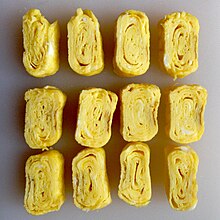 Tamagoyaki in Tokyo Tamagoyaki in Tokyo | |
| Type | Omelette |
|---|---|
| Course | Breakfast |
| Place of origin | Japan |
| Main ingredients | Egg |
| Variations | Usuyaki-tamago, kinshi-tamago, iri-tamago |
Tamagoyaki (卵焼き or 玉子焼き, literally 'grilled egg') is a type of Japanese omelette made by rolling together several layers of fried beaten eggs. It is often prepared in a rectangular omelette pan called a makiyakinabe or tamagoyaki. The word "tamago" means egg in Japanese, and the word "yaki" means to be cooked over direct heat.
History
Chicken and chicken eggs were first consumed in Japan in the early Edo period (1603-1867), when the ban on eating chicken meat and eggs was lifted. The tamagoyaki first appeared as a food for the chōnin (townspeople) of the Edo period. At that time, it was called "tamago fuwafuwa" and was made by boiling soup broth made by leaching umami ingredients from konbu (edible kelp) and katsuobushi (dried bonito flakes), adding beaten egg, and steaming. Ōgiya (扇屋), a famous tamagoyaki shop that opened in Ōji in 1648 and is still in business today, appears in Utagawa Hiroshige's ukiyo-e "Edo kōmei kaitei zukushi" (江戸高名会亭尽) and in the rakugo story performance "Ōji no kitsune" (王子の狐). Ōji and Asukayama, famous for cherry blossoms, were lined with ryōtei (traditional Japanese restaurants) and teahouses, and Ōgiya was one of them.
Tamagoyaki became popular in Japan in the 1950s, when the government encouraged parents to feed their children more protein, and farmers started raising more chickens. By the 1960s, tamagoyaki was so popular with Japanese children that there was a common saying within Japan that tamagoyaki was one of three things most loved by Japanese children, along with the Giants (a Japanese baseball team), and Taiho (sumo wrestler).
Preparation
Further information: Makiyakinabe § uses

There are several types of tamagoyaki. It is made by combining eggs, sugar and salt. Additionally, soy sauce and mirin are used in some recipes.
Alternative versions include "dashimaki tamago" which adds dashi to the egg mix, a stock of dried bonito and kelp, or a version including a mix of shrimp puree, grated mountain yam, sake, and egg, turned into a custard-like cake.
Serving options
In Japan, tamagoyaki is commonly served as a breakfast dish.
Sushi
Tamagoyaki is served around the world in the form of nigiri, and also appears in many types of sushi rolls. In the days when most sushi establishments made their own tamagoyaki, known as gyoku in sushi parlance, connoisseur customers would order the tamago sushi prior to starting their meal to assess the sushi chef's skills.
Large futomaki rolls often use tamagoyaki as an ingredient.
Similar dishes

In Japan, there are several similar dishes to tamagoyaki, such as usuyaki-tamago, kinshi-tamago, and iri-tamago. They differ by their thicknesses, and the manner in which they are fried. Usuyaki-tamago is thinner, kinshi-tamago is a kind of usuyaki-tamago that is cut like fine threads, and iri-tamago is similar to scrambled eggs.
Datemaki (伊達巻), traditionally eaten on New Year's, is prepared similarly to tamagoyaki, but incorporates fish paste or hanpen into the batter.
See also
References
- Krämer, Hans Martin (2008-03-14). ""Not Befitting Our Divine Country": Eating Meat in Japanese Discourses of Self and Other from the Seventeenth Century to the Present" (PDF). Food and Foodways. 16 (1). Informa UK Limited: 33–62. doi:10.1080/07409710701885135. ISSN 0740-9710.
- 玉子焼き (in Japanese). Ministry of Agriculture, Forestry and Fisheries (Japan). Archived from the original on 25 October 2022. Retrieved 20 February 2024.
- Itoh, Makiko (2015-04-17). "The holy trinity of the '60s: sumo, baseball and tamagoyaki". The Japan Times. Retrieved 2023-09-22.
- "Tamagoyaki | Traditional Egg Dish From Japan | TasteAtlas". www.tasteatlas.com. Retrieved 2023-09-22.
- Guthrie, David. "Futomaki". All About Sushi Guide. DCG Worldwide Inc. Archived from the original on 25 May 2014.
- "Tamagoyaki (Japanese Rolled Omelette) 玉子焼き". 23 August 2019.
- Hallock, Betty (14 March 2012). "Lunch with David Gelb, director of 'Jiro Dreams of Sushi'". Los Angeles Times. Retrieved 18 December 2014.
- Masato Shimizu (9 March 2012). Eaton, Tressa (ed.). "Tamago Omelet Recipe-". Tasting Table. Retrieved 18 December 2014.
- O'Donoghue, J. J. (2019-05-25). "Lorimer: Japanese breakfast, New York inflections". Japan Times.
- Omae, Kinjiro; Tachibana, Yuzuru (1988). The Book of Sushi. Kodansha International. p. 19. ISBN 9780870118661.
- Masui, Kazuko; Masui, Chihiro (2005). Sushi Secrets. Hachette Illustrated. ISBN 9781844301812.
- Knelly, Clarice (2022-10-26). "Datemaki: The Japanese Rolled Omelet That's A New Year Tradition". Tasting Table. Retrieved 2024-03-04.
| Japanese food and drink | |||||||||
|---|---|---|---|---|---|---|---|---|---|
| Shushoku |
| ||||||||
| Okazu | |||||||||
| Soup (Shirumono) | |||||||||
| Set menu | |||||||||
| Beverages |
| ||||||||
| Snacks / desserts/ Wagashi | |||||||||
| Fruits | |||||||||
| Ingredients / condiments | |||||||||
| Utensils | |||||||||
| Lists | |||||||||
| Related | |||||||||